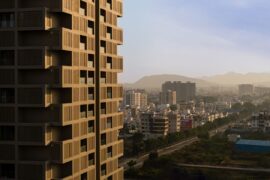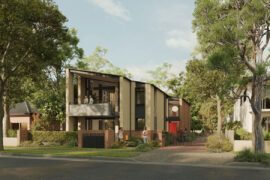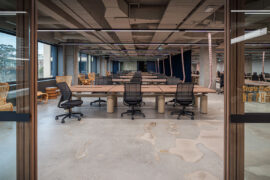What happens when the indoor-outdoor boundary is dissolved? Formwerkz Architects create expansive, continuous spaces for a family in a Singapore neighbourhood without maximising the floor area. Here’s a glimpse of our Cubes 86 feature!

Verandah House by Formwerkz Architects. Photography by Fabian Ong (courtesy of Formwerkz Architects)
June 29th, 2017
Private landed houses notoriously make up a slim five per cent (approximately) of the total number of residential households in Singapore. The larger semi-detached and detached plots correspondingly make up the minority of the five per cent. Thus working on one is a luxury that increasingly few architects encounter.
Formwerkz Architects, a familiar face to the private landed house scene, enjoyed this opportunity at a house off Holland Road. The clients, a couple with three children, approached the firm in early 2015 with the intention of reconstructing their existing 200-square-metre house that was built in the 1970s in order to meet their growing family’s needs. While maximising the built-up area was not the main priority, the family requested a separate bedroom for each child and a swimming pool larger than the original one. As they entertain fairly regularly, they were also keen to have common areas that would allow flexible usage, such that two different functions could take place simultaneously with the option of combining them should the need arise.
The site is nestled into a largely residential area, with a long driveway that leads up to it from the road; thus the common problems of noise and privacy did not pose as much of an issue as they might for projects in more urban settings. Formwerkz partner Alan Tay explains that the family was happy with approximately 700 square metres (as opposed to the 1,000-1,200 square metres that is common in most good class bungalows). He comments that this allowed the design team to focus on integrating the surrounding landscape with the interior by creating generous transition spaces in between. The strategy, he elaborates, was to build to the maximum on the ground floor to provide ample common spaces, and keep the built area of the upper floor to a minimum, dedicated only to the bedrooms.
Read the whole story in Cubes 86. Out now!
INDESIGN is on instagram
Follow @indesignlive
A searchable and comprehensive guide for specifying leading products and their suppliers
Keep up to date with the latest and greatest from our industry BFF's!

How can design empower the individual in a workplace transforming from a place to an activity? Here, Design Director Joel Sampson reveals how prioritising human needs – including agency, privacy, pause and connection – and leveraging responsive spatial solutions like the Herman Miller Bay Work Pod is key to crafting engaging and radically inclusive hybrid environments.
The new range features slabs with warm, earthy palettes that lend a sense of organic luxury to every space.

It’s widely accepted that nature – the original, most accomplished design blueprint – cannot be improved upon. But the exclusive Crypton Leather range proves that it can undoubtedly be enhanced, augmented and extended, signalling a new era of limitless organic materiality.

Screen 504 is a multi-residential building that pays homage to the past by reinterpreting traditional design for the future.

Featuring designs by Studio Johnston, Sam Crawford Architects, SAHA and others, the NSW Pattern Book for low-rise homes is a milestone in housing design.
The internet never sleeps! Here's the stuff you might have missed

‘What a Ripper!’ by comedian and architecture advocate Tim Ross explores Australia’s rich legacy of local product design.

Architectus Principals Simone Oliver and Patricia Bondin are set to speak at WORKTECH Sydney this year, so we asked them for some sneaky early insights on workplace design.

The client’s brief was clear: create an environment that honoured FIN’s heritage while embracing its future. For Intermain, that meant rejecting the idea of the corporate, “boring” office and instead leaning into a space that would inspire, connect, and surprise.